
The Atlantic tripletail, or tripletail, is a species of marine ray-finned fish belonging to the family Lobotidae. This fish is found in tropical and subtropical waters around the world except for the eastern Pacific Ocean.

The white crappie is a freshwater fish found in North America, one of the two species of crappies. Alternate common names for the species include goldring, silver perch, white perch and sac-a-lait. USS Goldring is named for the fish. The genus name Pomoxis refers to crappies' sharp operculum, while the species name annularis means 'having rings', i.e., it has vaguely vertical bars on the body.

The black crappie is a freshwater fish found in North America, one of the two types of crappies. It is very similar to the white crappie in size, shape, and habits, except that it is darker, with a pattern of black spots.

The California corbina, or California kingcroaker, is marine demersal fish in the croaker family. It can often be found along sandy beaches and in shallow bays. This species travels in small groups along the surf zone in a few inches of water to depths of 20 meters (66 ft). Other names include "California kingcroaker," "California whiting," and "kingfish".
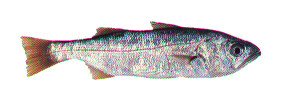
The queenfish is a species of fish in the family Sciaenidae, the drums and croakers. It is native to the eastern Pacific Ocean, where it occurs along the North American coastline from Oregon to Baja California; it has been recorded as far north as British Columbia. Its centre of distribution is the Southern California Bight. It is also known commonly as the queen croaker. This is the only species in the monotypic genus Seriphus.
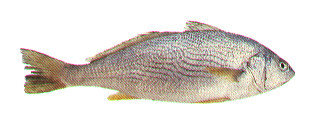
The yellowfin croaker is a species of croaker occurring from the Gulf of California, Mexico, to Point Conception, California. They frequent bays, channels, harbors and other nearshore waters over sandy bottoms. These croakers are more abundant along beaches during the summer months and may move to deeper water in winter. There is no set size limit for the yellowfin croaker.

The grey triggerfish, or gray triggerfish, is a species of ray-finned fish in the triggerfish family. The species is native to shallow parts of the western Atlantic from Nova Scotia to Argentina and also the eastern Atlantic, the Mediterranean Sea and off Angola on the west coast of Africa.

Paralabrax clathratus, the kelp bass, bull bass or calico bass, is a species of marine ray-finned fish, a sea bass from the subfamily Serraninae, classified as part of the family Serranidae which includes the groupers and anthias. It is found in the eastern North Pacific Ocean where it is an important species for both recreational and commercial fisheries.

Anarhichas minor, the spotted wolffish, spotted sea cat or leopardfish, is a large marine fish of the family Anarhichadidae. This bottom-dwelling species is found across the North Atlantic and adjacent parts of the Arctic Ocean from north of Russia and the Scandinavian Peninsula to the Scotian Shelf, off Nova Scotia, Canada. In Canada the population declined by about 90% from the late 1970s through the early 1990s, particularly in the northern part of its range. In Canada it is classified as a threatened species.

The Gulf grouper is a species of marine ray-finned fish, a grouper from the subfamily Epinephelinae which is part of the family Serranidae, which also includes the anthias and sea basses. It is endemic to Mexico.

The sawtail grouper is a species of marine ray-finned fish, a grouper from the subfamily Epinephelinae which is part of the family Serranidae, which also includes the anthias and sea basses.. It is endemic to the western coasts of Mexico. The sawtail grouper commonly lives on fields of large boulders with gorgonians and black corals.
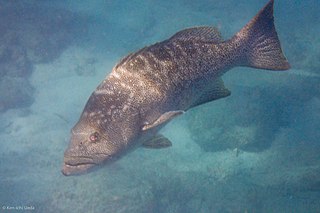
Mycteroperca rosacea, the leopard grouper or golden grouper, is a species of marine ray-finned fish, a grouper from the subfamily Epinephelinae which is part of the family Serranidae, which also includes the anthias and sea basses. It is found in the Eastern Central Pacific that occasionally makes its way into the aquarium trade.

The cocinero, also known as the barred jack and striped jack, is a species of small marine fish classified in the jack family, Carangidae. The cocinero is distributed through the tropical eastern Pacific Ocean, ranging along the west American coastline from Baja California in the north to Peru in the south. It is a pelagic species, inhabiting the upper water column in both coastal and offshore oceanic waters, occasionally making its way into estuaries. The species may be identified by its colouration, having 8 or 9 incomplete dark vertical stripes on its sides, with scute and gill raker counts also diagnostic. It is small compared to most other species of Caranx, reaching a length of 37 cm in total. The cocinero is a predatory fish, taking small fishes, crustaceans, and various benthic invertebrates in shallower waters. Little is known of the species' reproductive habits. The cocinero is of moderate importance to fisheries along the west coast of South America, and the species has been used in aquaculture trials. It is taken by various netting methods and by spear, and is sold fresh, dried, and salted at market.

The rex sole is a flatfish of the family Pleuronectidae. Locally, it may also be known as a witch or threadfin sole. It is a demersal fish that lives in temperate waters on sand or mud bottoms at depths of up to 900 metres (3,000 ft), though it is most commonly found between 61 and 500 metres. Its native habitat is the northern Pacific, from Baja California in Mexico up the coasts of the United States, British Columbia and Alaska, across the Bering Sea to the coast of Russia and the Sea of Japan. It is slow-growing, reaching up to 60 centimetres (24 in) in length, and it can weigh up to 2.0 kilograms (4.4 lb). Maximum reported lifespan is 24 years.

Spinachia is a monospecific genus of ray-finned fish belonging to the family Gasterosteidae, the sticklebacks. The only species in the genus is Spinachia spinachia, the sea stickleback, fifteen-spined stickleback or fifteenspine stickleback, a species which lives in benthopelagic and in brackish environments of the northeastern Atlantic Ocean. This species, the largest of the sticklebacks, grows to a length of 22 centimetres (8.7 in) SL. This species is the only known member of its genus Spinachia. It is of no interest as a commercial fish.

Menticirrhus saxatilis, the northern kingfish or northern kingcroaker, is a species of marine fish in the family Sciaenidae. It lives in the shallow coastal waters of the western Atlantic Ocean and Gulf of Mexico.
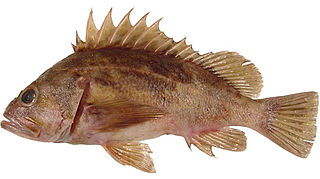
The brown rockfish, whose other names include brown seaperch, chocolate bass, brown bass and brown bomber, is a species of marine ray-finned fish belonging to the subfamily Sebastinae, the rockfishes, part of the family Scorpaenidae. It is found in the northeastern Pacific Ocean.

Cynoscion arenarius, sand seatrout, sand weakfish or white trout, is a species of marine ray-finned fish belonging to the family Sciaenidae, the drums and croakers. It is found in the western Atlantic Ocean. It is closely related to the common weakfish and may be a subspecies of C. regalis.
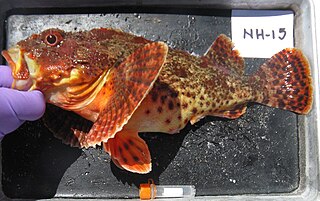
Scorpaena guttata is a species of fish in the scorpionfish family known by the common name California scorpionfish. It is native to the eastern Pacific Ocean, where it can be found along the coast of California and Baja California. Its distribution extends from around Santa Cruz, California, to Punta Abreojos in Baja California Sur, and out to Guadalupe Island. It is also found in the Gulf of California. Another common name is spotted scorpionfish.

The spotted bay bass is a species of marine ray-finned fish, a sea bass from the subfamily Serraninae, classified as part of the family Serranidae which includes the groupers and anthias. It is found in the central eastern Pacific Ocean.





















